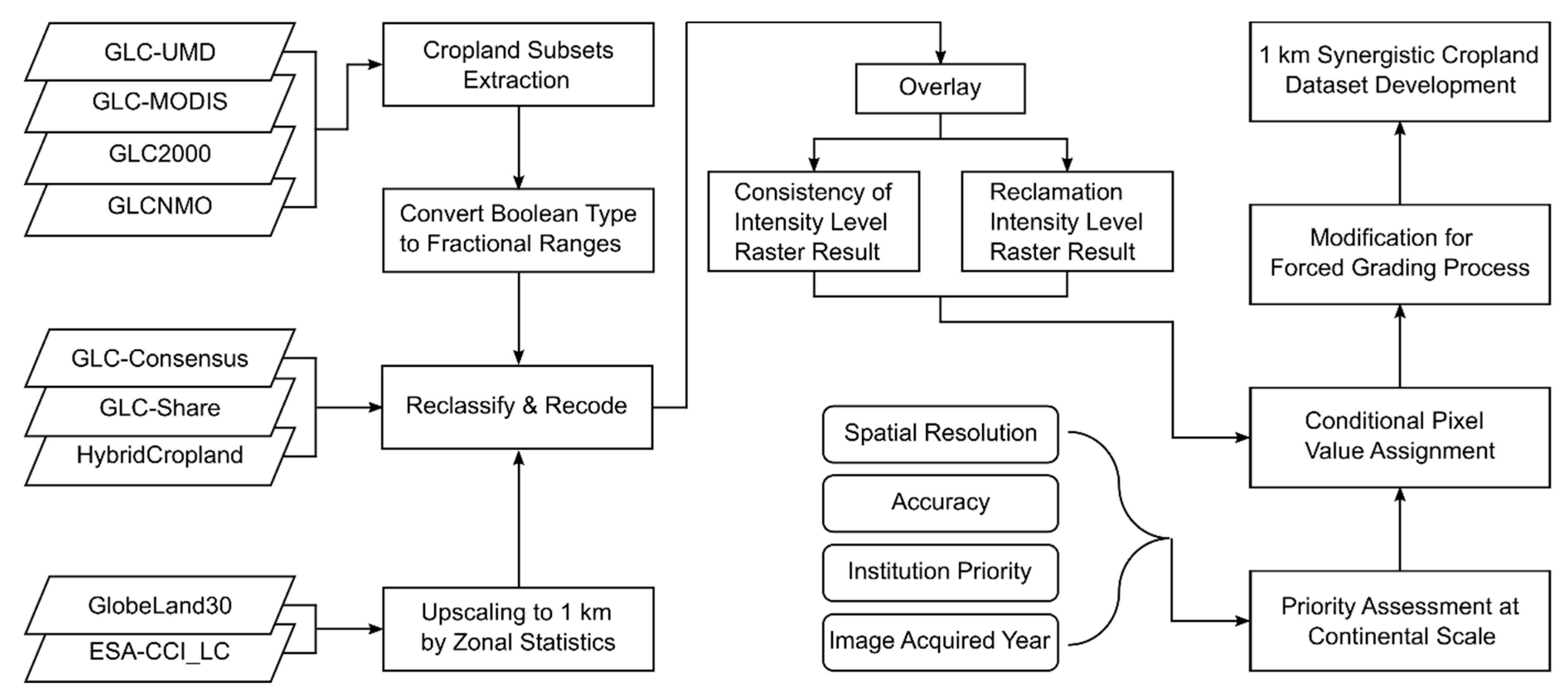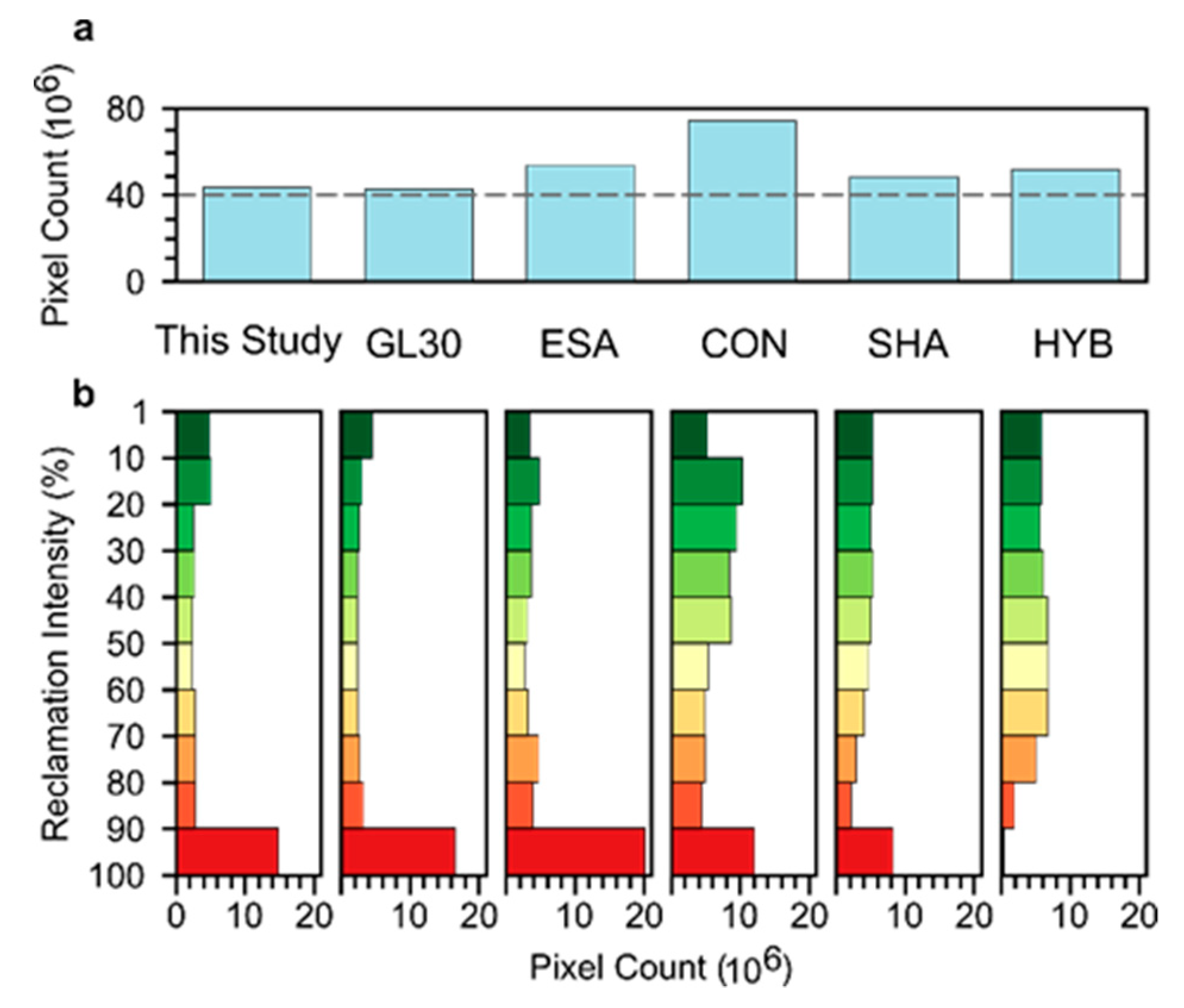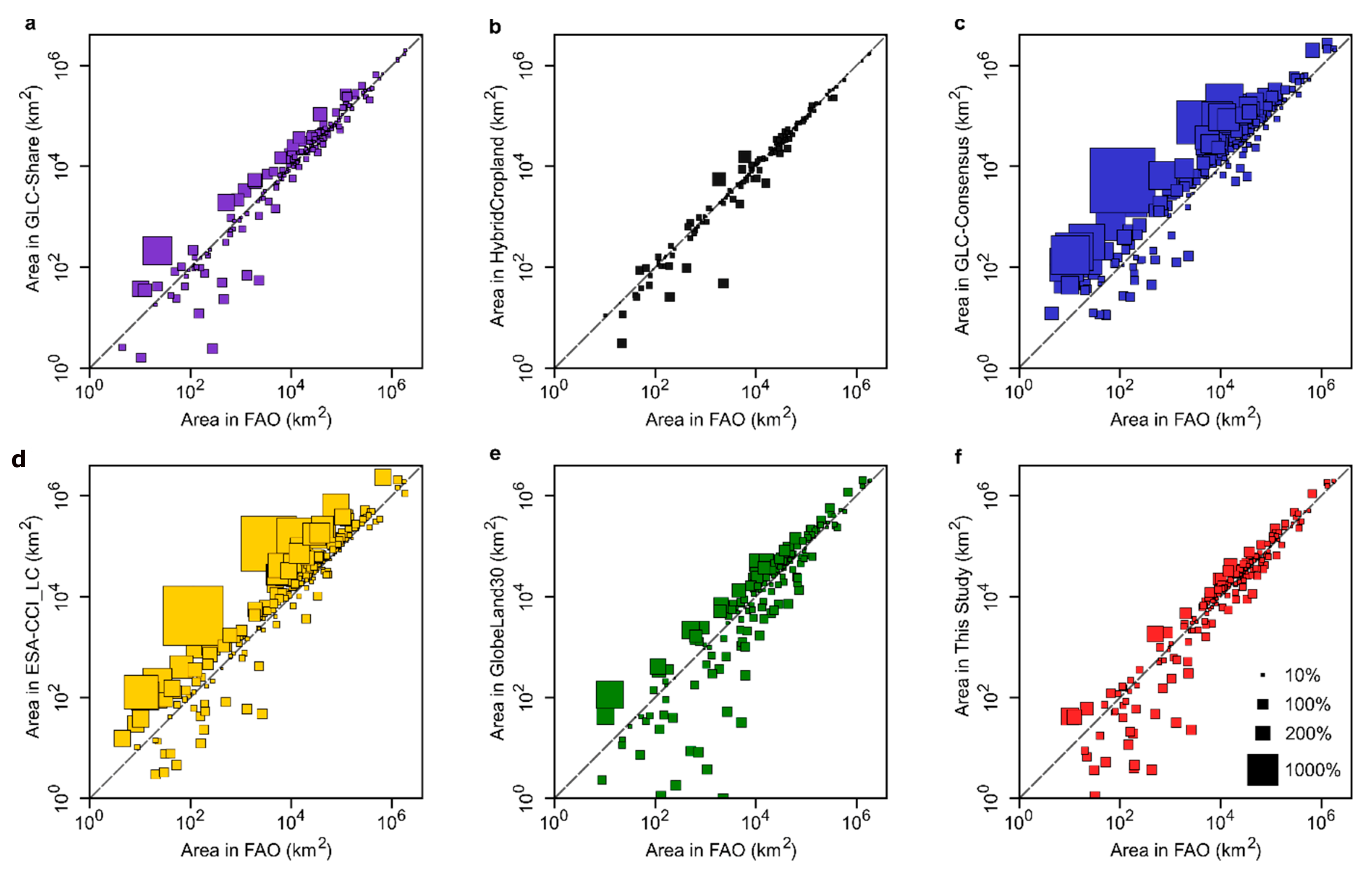Synergistic Modern Global 1 Km Cropland Dataset Derived from Multi-Sets of Land Cover Products
Abstract
1. Introduction
2. Materials and Methods
2.1. Data Sources
2.2. Methods
2.2.1. Cropland Subset Extraction and Reclamation Intensity Reclassification
2.2.2. Analysis of Spatial Consistency of Cropland Reclamation Intensity and Cropland Dataset Synergizing
2.2.3. Modification of the Primary Synergistic Result
2.2.4. Accuracy Assessment of the Cropland Datasets
2.2.5. The Quantitative Assessment of Cropland Area of Fractional Cropland Datasets
3. Results and Interpretations
3.1. Spatial Distribution of the Synergistic Cropland Dataset
3.2. Accuracy of the Reclamation Intensity Characteristics in the Synergistic Cropland Dataset
3.3. Spatial Accuracy and Areal Reasonability of the Synergistic Cropland Datasets
4. Discussion
4.1. Improvement of Spatial Distribution and Cropland Fraction on Pixel Scale in this Dataset
4.2. The Uncertainty in Accuracy Assessment of Fractional Dataset Datasets
5. Conclusions
- (1)
- The accuracy of spatial distribution assessed by validation samples in this new synergistic dataset reaches 87.6%. Besides the high accuracy, the dataset has a moderate amount of cropland pixel comparing with the products used in this study;
- (2)
- The reliability of the cropland fraction on the pixel scale has greatly improved that is the large proportion of cropland pixels is with higher fraction (over 90%) in this dataset. The histogram of pixel numbers with different reclamation intensities exhibits an “L” shape that was not found in previous synergistic fractional cropland datasets. This feature is reasonable because it is consistent with the up-scaling results derived from satellite-derived products with high spatial resolutions and the principle of cultivation;
- (3)
- The cropland areas in this non-calibrated result are generally closer to that of FAOSTAT on the scales from global to national when compared to other non-calibrated synergistic datasets and original satellite-derived products;
- (4)
- The reliability of the synergistic result developed by this method might decrease to some degree, especially in the regions where there are huge discrepancies among original multi-sets of datasets.
Supplementary Materials
Author Contributions
Funding
Acknowledgments
Conflicts of Interest
References
- Foley, J.A.; DeFries, R.; Asner, G.P.; Barford, C.; Bonan, G.; Carpenter, S.R.; Chapin, F.S.; Coe, M.T.; Daily, G.C.; Gibbs, H.K.; et al. Global consequences of land use. Science 2005, 309, 570–574. [Google Scholar] [CrossRef] [PubMed]
- Lambin, E.F.; Geist, H.J. Land-Use and Land-Cover Change: Local Processes and Global Impacts; Springer Science & Business Media: Berlin, Germany, 2008. [Google Scholar]
- Eitelberg, D.A.; van Vliet, J.; Verburg, P.H. A review of global potentially available cropland estimates and their consequences for model-based assessments. Glob. Chang. Biol. 2015, 21, 1236–1248. [Google Scholar] [CrossRef] [PubMed]
- Goldewijk, K.K.; Beusen, A.; Doelman, J.; Stehfest, E. Anthropogenic land use estimates for the Holocene–HYDE 3.2. Earth Syst. Sci. Data 2017, 9, 927–953. [Google Scholar] [CrossRef]
- Ruddiman, W.F. The anthropogenic greenhouse era began thousands of years ago. Clim. Chang. 2003, 61, 261–293. [Google Scholar] [CrossRef]
- Matthews, H.D.; Weaver, A.J.; Eby, M.; Meissner, K.J. Radiative forcing of climate by historical land cover change. Geophys. Res. Lett. 2003, 30, 1–4. [Google Scholar] [CrossRef]
- Douville, H.; Ribes, A.; Decharme, B.; Alkama, R.; Sheffield, J. Anthropogenic influence on multidecadal changes in reconstructed global evapotranspiration. Nat. Clim. Chang. 2013, 3, 59. [Google Scholar] [CrossRef]
- De Campos, C.P.; Muylaert, M.S.; Rosa, L.P. Historical CO2 emission and concentrations due to land use change of croplands and pastures by country. Sci. Total Environ. 2005, 346, 149–155. [Google Scholar] [CrossRef]
- Liu, J.; You, L.; Amini, M.; Obersteiner, M.; Herrero, M.; Zehnder, A.J.; Yang, H. A high-resolution assessment on global nitrogen flows in cropland. Proc. Natl. Acad. Sci. USA 2010, 107, 8035–8040. [Google Scholar] [CrossRef]
- Houghton, R.A.; House, J.I.; Pongratz, J.; Van Der Werf, G.R.; DeFries, R.S.; Hansen, M.C.; Quéré, L.; Ramankutty, N. Carbon emissions from land use and land-cover change. Biogeosciences 2012, 9, 5125–5142. [Google Scholar] [CrossRef]
- Fuchs, R.; Schulp, C.J.; Hengeveld, G.M.; Verburg, P.H.; Clevers, J.G.; Schelhaas, M.J.; Herold, M. Assessing the influence of historic net and gross land changes on the carbon fluxes of Europe. Glob. Chang. Biol. 2016, 22, 2526–2539. [Google Scholar] [CrossRef]
- Haines-Young, R. Land use and biodiversity relationships. Land Use Policy 2009, 26, S178–S186. [Google Scholar] [CrossRef]
- Newbold, T.; Hudson, L.N.; Arnell, A.P.; Contu, S.; De Palma, A.; Ferrier, S.; Hill, S.L.L.; Hoskins, A.J.; Lysenko, I.; Phillips, H.R.P.; et al. Has land use pushed terrestrial biodiversity beyond the planetary boundary? Glob. Assess. Sci. 2016, 353, 288–291. [Google Scholar]
- Sterling, S.M.; Ducharne, A.; Polcher, J. The impact of global land-cover change on the terrestrial water cycle. Nat. Clim. Chang. 2013, 3, 385. [Google Scholar] [CrossRef]
- Lobell, D.B.; Bala, G.; Duffy, P.B. Biogeophysical impacts of cropland management changes on climate. Geophys. Res. Lett. 2006, 33, 1–4. [Google Scholar] [CrossRef]
- Nelson, G.C.; Robertson, R.D. Comparing the GLC2000 and GeoCover LC land cover datasets for use in economic modelling of land use. Int. J. Remote Sens. 2007, 28, 4243–4262. [Google Scholar] [CrossRef]
- Sertel, E.; Robock, A.; Ormeci, C. Impacts of land cover data quality on regional climate simulations. Int. J. Clim. 2010, 30, 1942–1953. [Google Scholar] [CrossRef]
- Fritz, S.; See, L.; McCallum, I.; You, L.; Bun, A.; Moltchanova, E.; Havlik, P. Mapping global cropland and field size. Glob. Chang. Biol. 2015, 21, 1980–1992. [Google Scholar] [CrossRef]
- Giri, C.; Zhu, Z.; Reed, B. A comparative analysis of the Global Land Cover 2000 and MODIS land cover data sets. Remote Sens. Environ. 2005, 94, 123–132. [Google Scholar] [CrossRef]
- Ran, Y.; Li, X.; Lu, L. Evaluation of four remote sensing based land cover products over China. Int. J. Remote Sens. 2010, 31, 391–401. [Google Scholar] [CrossRef]
- Joshi, N.; Baumann, M.; Ehammer, A.; Fensholt, R.; Grogan, K.; Hostert, P.; Jepsen, M.; Kuemmerle, T.; Meyfroidt, P.; Mitchard, E.; et al. A Review of the Application of Optical and Radar Remote Sensing Data Fusion to Land Use Mapping and Monitoring. Remote Sens. 2016, 8, 70. [Google Scholar] [CrossRef]
- Thanh Noi, P.; Kappas, M. Comparison of random forest, k-nearest neighbor, and support vector machine classifiers for land cover classification using Sentinel-2 imagery. Sensors 2018, 18, 18. [Google Scholar] [CrossRef] [PubMed]
- Grekousis, G.; Mountrakis, G.; Kavouras, M. An overview of 21 global and 43 regional land-cover mapping products. Int. J. Remote Sens. 2015, 36, 5309–5335. [Google Scholar] [CrossRef]
- Verburg, P.H.; Neumann, K.; Nol, L. Challenges in using land use and land cover data for global change studies. Glob. Chang. Biol. 2011, 7, 974–989. [Google Scholar] [CrossRef]
- Loveland, T.R.; Reed, B.C.; Brown, J.F.; Ohlen, D.O.; Zhu, Z.; Yang, L.; Merchant, J.W. Development of a global land cover characteristics database and IGBP DISCover from 1 km AVHRR data. Int. J. Remote Sens. 2000, 21, 1303–1330. [Google Scholar] [CrossRef]
- Yadav, K.; Congalton, R. Accuracy assessment of global food security-support analysis data (GFSAD) cropland extent maps produced at three different spatial resolutions. Remote Sens. 2018, 10, 1800. [Google Scholar] [CrossRef]
- Friedl, M.A.; McIver, D.K.; Hodges, J.C.; Zhang, X.Y.; Muchoney, D.; Strahler, A.H.; Woodcock, C.E.; Gopal, S.; Schneider, A.; Cooper, A.; et al. Global land cover mapping from MODIS: Algorithms and early results. Remote Sens. Environ. 2002, 83, 287–302. [Google Scholar] [CrossRef]
- Bontemps, S.; Defourny, P.; Radoux, J.; Van Bogaert, E.; Lamarche, C.; Achard, F.; Mayaux, P.; Boettcher, M.; Brockmann, C.; Kirches, G.; et al. Consistent global land cover maps for climate modelling communities: Current achievements of the ESA’s land cover CCI. In Proceedings of the ESA Living Planet Symposium, Edimburgh, UK, 9–13 September 2013; pp. 1–6. [Google Scholar]
- Yu, L.; Wang, J.; Clinton, N.; Xin, Q.; Zhong, L.; Chen, Y.; Gong, P. FROM-GC: 30 m global cropland extent derived through multisource data integration. Int. J. Digit. Earth 2013, 6, 521–533. [Google Scholar] [CrossRef]
- Matthews, E. Global vegetation and land use: New high-resolution data bases for climate studies. J. Clim. Appl. Meteorol. 1983, 22, 474–487. [Google Scholar] [CrossRef]
- De Fries, R.S.; Hansen, M.; Townshend, J.R.G.; Sohlberg, R. Global land cover classifications at 8 km spatial resolution: The use of training data derived from Landsat imagery in decision tree classifiers. Int. J. Remote Sens. 1998, 19, 3141–3168. [Google Scholar] [CrossRef]
- Gong, P.; Liu, H.; Zhang, M.; Li, C.; Wang, J.; Huang, H.; Clinton, N.; Ji, L.; Li, W.; Bai, Y.; et al. Stable classification with limited sample: Transferring a 30-m resolution sample set collected in 2015 to mapping 10-m resolution global land cover in 2017. Sci. Bull. 2019, 64, 370–373. [Google Scholar] [CrossRef]
- Xiao, X.; Liu, J.; Zhuang, D.; Frolking, S.; Boles, S.; Xu, B.; Liu, M.; Salas, W.; Moore, B.; Li, C. Uncertainties in estimates of cropland area in China: A comparison between an AVHRR-derived dataset and a Landsat TM-derived dataset. Glob. Planet. Chang. 2003, 37, 297–306. [Google Scholar] [CrossRef]
- McCallum, I.; Obersteiner, M.; Nilsson, S.; Shvidenko, A. A spatial comparison of four satellite derived 1 km global land cover datasets. Int. J. Appl. Earth Obs. 2006, 8, 246–255. [Google Scholar] [CrossRef]
- Lu, M.; Wu, W.; Zhang, L.; Liao, A.; Peng, S.; Tang, H. A comparative analysis of five global cropland datasets in China. Sci. China Ser. D 2016, 59, 2307–2317. [Google Scholar] [CrossRef]
- Pérez-Hoyos, A.; Rembold, F.; Kerdiles, H.; Gallego, J. Comparison of global land cover datasets for cropland monitoring. Remote Sens. 2017, 9, 1118. [Google Scholar] [CrossRef]
- Liu, X.X.; Yu, L.; Li, W.; Peng, D.L.; Zhong, L.H.; Li, L.; Xin, Q.C.; Yu, C.Q.; Gong, P. Comparison of country-level cropland areas between ESA-CCI land cover maps and FAOSTAT data. Int. J. Remote Sens. 2018, 39, 6631–6645. [Google Scholar] [CrossRef]
- Samasse, K.; Hanan, N.; Tappan, G.; Diallo, Y. Assessing Cropland Area in West Africa for Agricultural Yield Analysis. Remote Sens. 2018, 10, 1785. [Google Scholar] [CrossRef]
- Herold, M.; Mayaux, P.; Woodcock, C.E.; Baccini, A.; Schmullius, C. Some challenges in global land cover mapping: An assessment of agreement and accuracy in existing 1 km datasets. Remote Sens. Environ. 2008, 112, 2538–2556. [Google Scholar] [CrossRef]
- Jung, M.; Henkel, K.; Herold, M.; Churkina, G. Exploiting synergies of global land cover products for carbon cycle modeling. Remote Sens. Environ. 2006, 101, 534–553. [Google Scholar] [CrossRef]
- Latham, J.; Cumani, R.; Rosati, I.; Bloise, M. Global Land Cover Share (GLC-SHARE) Database Beta-Release Version 1.0-2014; FAO: Rome, Italy, 2014. [Google Scholar]
- Tsendbazar, N.E. Global Land Cover Map Validation, Comparison and Integration for Different User Communities. Ph.D. Thesis, Wageningen University, Wageningen, The Nederland, 2016. [Google Scholar]
- Tsendbazar, N.E.; de Bruin, S.; Herold, M. Integrating global land cover datasets for deriving user-specific maps. Int. J. Digit. Earth 2017, 10, 219–237. [Google Scholar] [CrossRef]
- Leff, B.; Ramankutty, N.; Foley, J.A. Geographic distribution of major crops across the world. Glob. Biogeochem. Cycles 2004, 18, 1–27. [Google Scholar] [CrossRef]
- Fritz, S.; You, L.; Bun, A.; See, L.; McCallum, I.; Schill, C.; Perger, C.; Liu, J.; Hansen, M.; Obersteiner, M. Cropland for sub-Saharan Africa: A synergistic approach using five land cover data sets. Geophys. Res. Lett. 2011, 38, 1–6. [Google Scholar] [CrossRef]
- Lu, M.; Wu, W.; You, L.; Chen, D.; Zhang, L.; Yang, P.; Tang, H. A synergy cropland of china by fusing multiple existing maps and statistics. Sensors 2017, 17, 1613. [Google Scholar] [CrossRef]
- Tuanmu, M.N.; Jetz, W. A global 1-km consensus land-cover product for biodiversity and ecosystem modelling. Glob. Ecol. Biogeogr. 2014, 23, 1031–1045. [Google Scholar] [CrossRef]
- Goldewijk, K.K.; Van Drecht, G.; Bouwman, A.F. Mapping contemporary global cropland and grassland distributions on a 5× 5 minute resolution. J. Land Use Sci. 2007, 2, 167–190. [Google Scholar] [CrossRef]
- Ramankutty, N.; Evan, A.T.; Monfreda, C.; Foley, J.A. Farming the planet: 1. Geographic distribution of global agricultural lands in the year 2000. Glob. Biogeochem. Cycles 2008, 22, 1–19. [Google Scholar] [CrossRef]
- Frolking, S.; Xiao, X.; Zhuang, Y.; Salas, W.; Li, C. Agricultural land-use in China: A comparison of area estimates from ground-based census and satellite-borne remote sensing: GCTE/LUCC RESEARCH LETTER. Glob. Ecol. Biogeogr. 1999, 8, 407–416. [Google Scholar] [CrossRef]
- Feng, Z.M.; Liu, B.Q.; Yang, Y.Z. A study of the changing trend of Chinese cultivated land amount and data reconstructing: 1949–2003. J. Nat. Resour. 2005, 20, 35–43. [Google Scholar]
- Hansen, M.C.; DeFries, R.S.; Townshend, J.R.; Sohlberg, R. Global land cover classification at 1 km spatial resolution using a classification tree approach. Int. J. Remote Sens. 2000, 21, 1331–1364. [Google Scholar] [CrossRef]
- Bartholomé, E.; Belward, A.S. GLC2000: A new approach to global land cover mapping from Earth observation data. Int. J. Remote Sens. 2005, 26, 1959–1977. [Google Scholar] [CrossRef]
- Tateishi, R.; Uriyangqai, B.; Al-Bilbisi, H.; Ghar, M.A.; Tsend-Ayush, J.; Kobayashi, T.; Enkhzaya, T. Production of global land cover data–GLCNMO. Int. J. Digit. Earth 2011, 4, 22–49. [Google Scholar] [CrossRef]
- Chen, J.; Chen, J.; Liao, A.; Cao, X.; Chen, L.; Chen, X.; He, C.; Han, G.; Peng, S.; Lu, M.; et al. Global land cover mapping at 30 m resolution: A POK-based operational approach. ISPRS J. Photogramm. 2015, 103, 7–27. [Google Scholar] [CrossRef]
- Wu, W.; Yu, Q.; You, L.; Chen, K.; Tang, H.; Liu, J. Global cropping intensity gaps: Increasing food production without cropland expansion. Land Use Policy 2018, 76, 515–525. [Google Scholar] [CrossRef]
- Lin, M.; Huang, Q. Exploring the relationship between agricultural intensification and changes in cropland areas in the US. Agr. Ecosyst. Environ. 2019, 274, 33–40. [Google Scholar] [CrossRef]
- Mazoyer, M.; Roudart, L. A History of World Agriculture: From the Neolithic Age to the Current Crisis; Routledge: London, UK, 2007. [Google Scholar]
- Tauger, M.B. Agriculture in World History; Routledge: London, UK, 2010. [Google Scholar]








| No | Product | Type | Resolution | Year | LCCS | Cropland Classes/Reclamation Ratio |
|---|---|---|---|---|---|---|
| 1 | GLC-UMD | Boolean | 1 km | 1992–1993 | Modified IGBP | 11. Croplands (81–100%) |
| Other classes (0–80%) | ||||||
| 2 | GLC-MODIS | Boolean | 1 km | 2001 | IGBP | 12. Croplands (61–100%) |
| 14. Cropland/Natural Vegetation Mosaics (11–60%) | ||||||
| Other classes (0–10%) | ||||||
| 3 | GLC2000 | Boolean | 1 km | 2000 | FAO | 16. Cultivated and managed areas (61–100%) |
| 17. Mosaic: Cropland/Tree Cover/Other natural vegetation (16–60%) | ||||||
| 18. Mosaic: Cropland/Shrub and/or grass cover (16–60%) | ||||||
| Other classes (0–15%) | ||||||
| 4 | GLCNMO | Boolean | 500 m | 2003 | Modified FAO | 11. Cropland (61–100%) |
| 12. Paddy field (61–100%) | ||||||
| 13. Cropland/other vegetation mosaic (16–60%) | ||||||
| Other classes (0–15%) | ||||||
| 5 | ESA-CCI-LC | Boolean | 300 m | 2000 | Modified FAO | 10. Cropland, rainfed (71–100%) |
| 11. Herbaceous cover (71–100%) | ||||||
| 12. Tree or shrub cover (71–100%) | ||||||
| 20. Cropland, irrigated or post-flooding (71–100%) | ||||||
| 30. Mosaic cropland/natural vegetation (51–70%) | ||||||
| 40. Mosaic natural vegetation / cropland (21–50%) | ||||||
| Other classes (0–20%) | ||||||
| 6 | GlobeLand30 | Boolean | 30 m | 2000 | China | 10. Cropland (100%) |
| 7 | HybridCropland | Fraction | 1 km | around 2000 | —— | (0–100%) |
| 8 | GLC-Share | Fraction | 1 km | around 2000 | Modified FAO | 2. Cropland (0–100%) |
| 9 | GLC-Consensus | Fraction | 1 km | around 2000 | Modified IGBP&FAO | 7. Cultivated and managed vegetation (0–100%) |
| Product | Accuracy | Product | Accuracy |
|---|---|---|---|
| GlobeLand30 | 89.94% | GLC-Consensus | 95.47% |
| ESA-CCI-LC | 87.68% | HybridCropland | 87.61% |
| GLC-MODIS | 67.53% | This Study | 87.61% |
| GLC2000 | 66.31% | GLC-Share | 87.07% |
| GLC-NMO | 64.19% | ||
| GLC-UMD | 40.01% |
| Region | This Study | ESA-CCI-LC | GlobeLand30 | GLC-Consensus | FAO | ||||
|---|---|---|---|---|---|---|---|---|---|
| Area | Diff | Area | Diff | Area | Diff | Area | Diff | Area | |
| AS | 6.43 | ▼12% | 7.87 | 37% | 6.88 | 19% | 9.06 | ▲57% | 5.76 |
| EU | 4.00 | 28% | 3.92 | ▼25% | 4.21 | 35% | 4.79 | ▲53% | 3.13 |
| OA | 0.54 | 7% | 0.48 | ▼−5% | 0.58 | 13% | 0.83 | ▲63% | 0.51 |
| AF | 2.15 | ▼−8% | 6.04 | ▲157% | 2.03 | −14% | 4.51 | 92% | 2.35 |
| NA | 2.33 | −4% | 1.56 | ▲−35% | 2.48 | ▼3% | 2.60 | 8% | 2.41 |
| LA | 2.27 | ▼39% | 4.33 | ▲165% | 2.42 | 48% | 4.07 | 149% | 1.63 |
| World | 17.73 | ▼12% | 24.20 | 53% | 18.59 | 18% | 25.85 | ▲64% | 15.79 |
© 2019 by the authors. Licensee MDPI, Basel, Switzerland. This article is an open access article distributed under the terms and conditions of the Creative Commons Attribution (CC BY) license (http://creativecommons.org/licenses/by/4.0/).
Share and Cite
Zhang, C.; Ye, Y.; Fang, X.; Li, H.; Wei, X. Synergistic Modern Global 1 Km Cropland Dataset Derived from Multi-Sets of Land Cover Products. Remote Sens. 2019, 11, 2250. https://doi.org/10.3390/rs11192250
Zhang C, Ye Y, Fang X, Li H, Wei X. Synergistic Modern Global 1 Km Cropland Dataset Derived from Multi-Sets of Land Cover Products. Remote Sensing. 2019; 11(19):2250. https://doi.org/10.3390/rs11192250
Chicago/Turabian StyleZhang, Chengpeng, Yu Ye, Xiuqi Fang, Hansunbai Li, and Xueqiong Wei. 2019. "Synergistic Modern Global 1 Km Cropland Dataset Derived from Multi-Sets of Land Cover Products" Remote Sensing 11, no. 19: 2250. https://doi.org/10.3390/rs11192250
APA StyleZhang, C., Ye, Y., Fang, X., Li, H., & Wei, X. (2019). Synergistic Modern Global 1 Km Cropland Dataset Derived from Multi-Sets of Land Cover Products. Remote Sensing, 11(19), 2250. https://doi.org/10.3390/rs11192250







